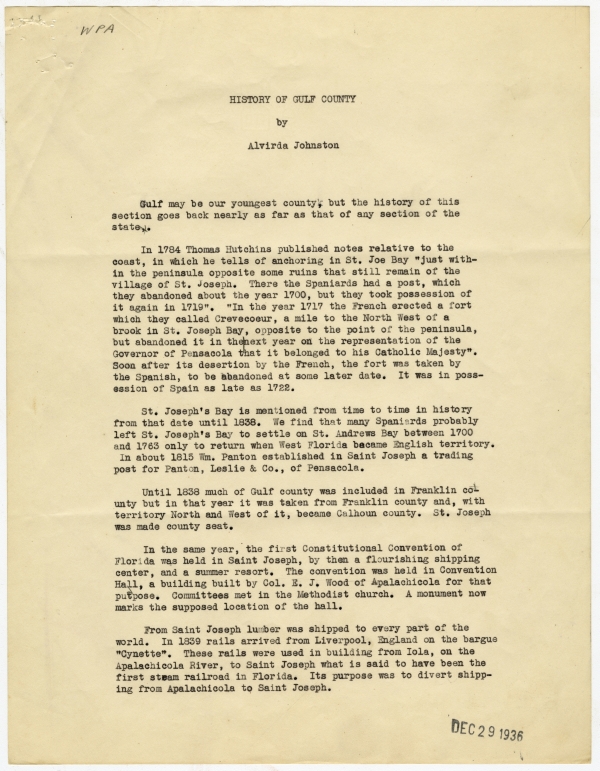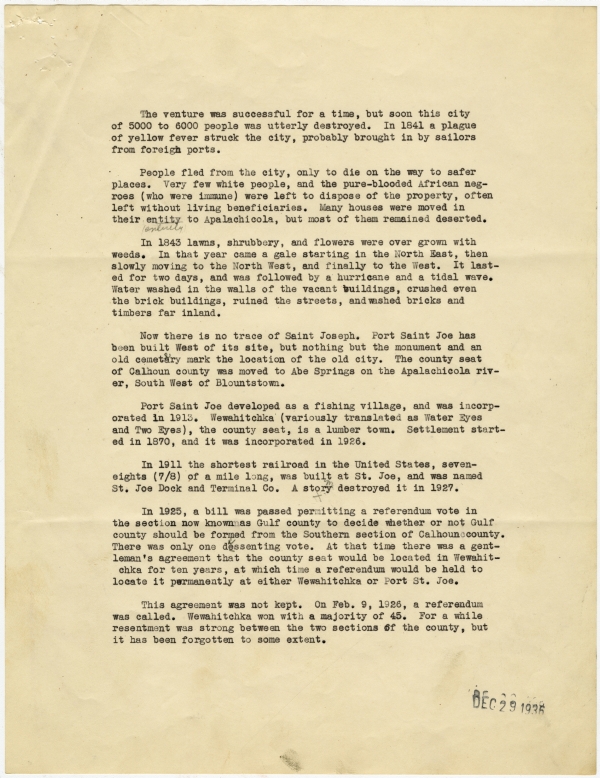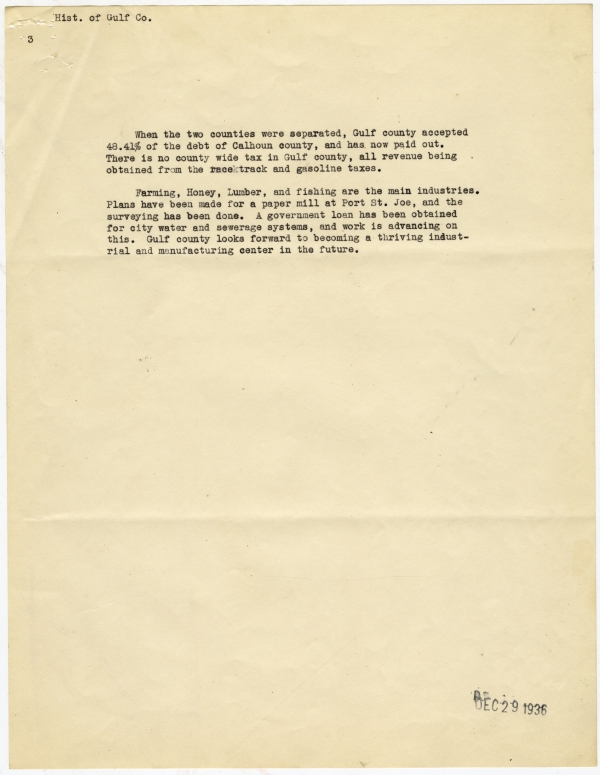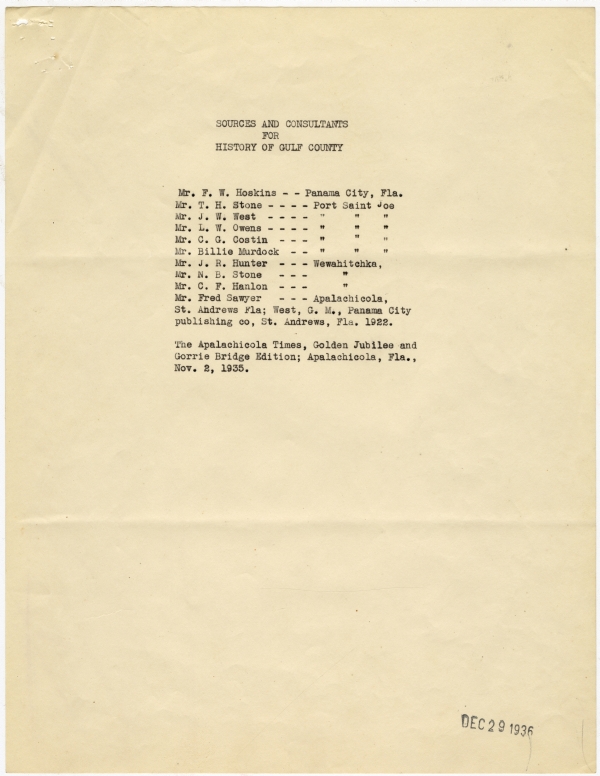WPA
HISTORY OF GULF COUNTY
by
Alvirda Johnston
Gulf may be our youngest county, but the history of this section goes back nearly as far as that of any section of the state.
In 1784 Thomas Hutchins published notes relative to the coast, in which he tells of anchoring in St. Joe Bay "just within the peninsula opposite some ruins that still remain of the village of St. Joseph. There the Spaniards had a post, which they abandoned about the year 1700, but they took possession of it again in 1719". "In the year 1717 the French erected a fort which they called Crevecoeur, a mile to the North West of a brook in St. Joseph Bay, opposite to the point of the peninsula, but abandoned it in the next year on the representation of the Governor of Pensacola that it belonged to his Catholic Majesty". Soon after its desertion by the French, the fort was taken by the Spanish, to be abandoned at some later date. It was in possession of Spain as late as 1722.
St. Joseph's Bay is mentioned from time to time in history from that date until 1838. We find that many Spaniards probably left St. Joseph's Bay to settle on St. Andrews Bay between 1700 and 1763 only to return when West Florida became English territory. In about 1813 Wm. Panton established in Saint Joseph a trading post for Panton, Leslie & Co., of Pensacola.
Until 1838 much of Gulf county was included in Franklin county but in that year it was taken from Franklin county and, with territory North and West of it, became Calhoun county. St. Joseph was made county seat.
In the same year, the first Constitutional Convention of Florida was held in Saint Joseph, by then a flourishing shipping center, and a summer resort. The convention was held in Convention Hall, a building built by Col, E. J. Wood of Apalachicola for that purpose. Committees met in the Methodist church. A monument now marks the supposed location of the hall.
From Saint Joseph lumber was shipped to every part of the world. In 1839 rails arrived from Liverpool, England on the bargue "Cynette". These rails were used in building from Iola, on the Apalachicola River, to Saint Joseph what is said to have been the first steam railroad in Florida. Its purpose was to divert shipping from Apalachicola to Saint Joseph.
DEC 29 1936
The venture was successful for a time, but soon this city of 5000 to 6000 people was utterly destroyed. In 1841 a plague of yellow fever struck the city, probably brought in by sailors from foreign ports.
People fled from the city, only to die on the way to safer places. Very few white people, and the pure-blooded African negroes (who were immune) were left to dispose of the property, often left without living beneficiaries. Many houses were moved in their entirety to Apalachicola, but most of them remained deserted.
In 1843 lawns, shrubbery, and flowers were over grown with weeds. In that year came a gale starting in the North East, then slowly moving to the North West, and finally to the West. It lasted for two days, and was followed by a hurricane and a tidal wave. Water washed in the walls of the vacant buildings, crushed even the brick buildings, ruined the streets, and washed bricks and timbers far inland.
Now there is no trace of Saint Joseph. Port Saint Joe has been built West of its site, but nothing but the monument and an old cemetery mark the location of the old city. The county seat of Calhoun county was moved to Abe Springs on the Apalachicola river, South West of Blountstown.
Port Saint Joe developed as a fishing village, and was incorporated in 1913. Wewahitchka (variously translated as Water Eyes and Two Eyes), the county seat, is a lumber town. Settlement started in 1870, and it was incorporated in 1926.
In 1911 the shortest railroad in the United States, seveneights [sic] (7/8) of a mile long, was built at St. Joe, and was named St. Joe Dock and Terminal Co. A storm destroyed it in 1927.
In 1925, a bill was passed permitting a referendum vote in the section now known as Gulf county to decide whether or not Gulf county should be formed from the Southern section of Calhoun county. There was only one [dissenting] vote. At that time there was a gentleman's agreement that the county seat would be located in Wewahitchka for ten years, at which time a referendum would be held to locate it permanently at either Wewahitchka or Port St. Joe.
This agreement was not kept. On Feb. 9, 1926, a referendum was called. Wewahitchka won with a majority of 45. For a while resentment was strong between the two sections of the county, but it has been forgotten to some extent.
DEC 29 1936
Hist. of Gulf Co.
3
When the two counties were separated, Gulf county accepted 48.41% of the debt of Calhoun county, and has now paid out. There is no county wide tax in Gulf county, all revenue being obtained from the race track and gasoline taxes.
Farming, Honey, Lumber, and fishing are the main industries. Plans have been made for a paper mill at Port. St. Joe, and the surveying has been done. A government loan has been obtained for city water and sewerage systems, and work is advancing on this. Gulf county looks forward to becoming a thriving industrial and manufacturing center in the future.
DEC 29 1936
SOURCES AND CONSULTANTS
FOR
HISTORY OF GULF COUNTY
Mr. F. W. Hoskins -- Panama City, Fla.
Mr. T. H. Stone ---- Port Saint Joe
Mr. J. W. West ---- " " "
Mr. L. W. Owens ---- " " "
Mr. C. G. Costin --- " " "
Mr. Billie Murdock -- " " "
Mr. J. R. Hunter --- Wewahitchka
Mr. N. B. Stone --- "
Mr. C. F. Hanlon --- "
Mr. Fred Sawyer --- Apalachicola,
St. Andrews Fla; West, G. M., Panama City
publishing co, St. Andrews, Fla. 1922.
The Apalachicola Times, Golden Jubilee and Gorrie Bridge Edition; Apalachicola, Fla., Nov. 2, 1935.
DEC 29 1936




 Listen: The Latin Program
Listen: The Latin Program

